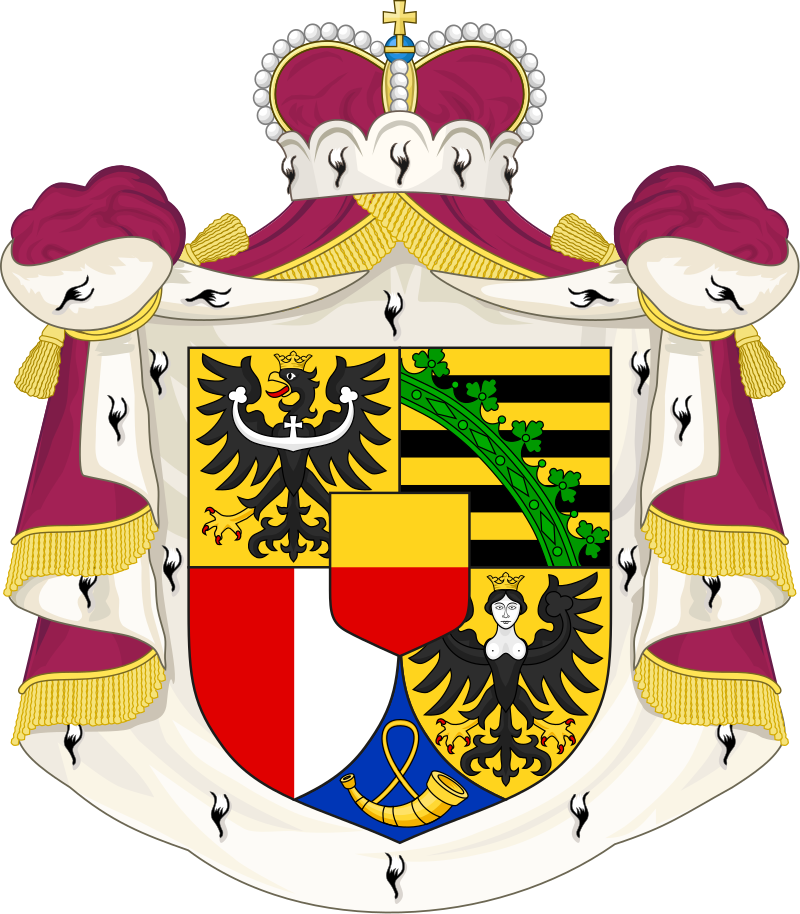orders of chivalry
principality of liechtenstein
Liechtenstein is a small country situated on the banks of the Rhine in Central Europe, between the Swiss canton of St. Gallen and the Austrian province of Vorarlberg. The official language is German, though day-to-day affairs are conducted in two Alemannic dialects. Comprising eleven municipalities, the principality is a constitutional hereditary monarchy on a parliamentary and democratic basis. The head of state is Prince Hans-Adam II von Liechtenstein.
Founding of the Principality
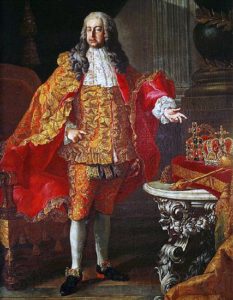
Holy roman emperor charles vi
In 1396 southern region of modern Liechtenstein became subject to the Holy Roman Emperor Sigismund.
The Liechtensteins, the family from which the principality takes its name, originally came from Liechtenstein Castle in Lower Austria. The family had possessed the castle from at least 1140 until the 13th century. It regained control of the castle in 1807. The Liechtensteins were land owners, holding predominantly in Moravia, Lower Austria, Silesia, and Styria. As these territories were all held in feudal tenure from more senior feudal lords, particularly the Habsburgs, the Liechtenstein dynasty was unable to meet a primary requirement to qualify for a seat in the Imperial Reichstag. Although several Liechtenstein lords served several Habsburg rulers as close advisers, without any territory held directly from the Imperial throne, they held no noble status within the Holy Roman Empire.
For this reason, the family sought to acquire lands that were granted directly from the Holy Roman Emperor. During the early 17th century, Karl I of Liechtenstein was made a prince by the Holy Roman Emperor Matthias after siding with him in a political battle. In 1699 Hans-Adam I was permitted to purchase the small Lordship of Schellenberg. In 1712 he purchased the county of Vaduz. Schellenberg and Vaduz were under direct control of the Emperor, giving the Lichtenstein’s the political status they desired.
On January 23, 1719, after the lands had been purchased, Charles VI, Holy Roman Emperor, decreed that Vaduz and Schellenberg were united and elevated the newly formed territory to the dignity of principality with the name “Liechtenstein”. It was on this date that Liechtenstein became a sovereign member state of the Holy Roman Empire.
culture of liechtenstein

the autumn tradition of bringing down the cattle
Most of Liechtenstein’s customs are drawn from Alemannic culture, with many also closely linked to the Catholic church and its holy days and rites. Customs are spread throughout the year and often mark the start or end of seasons or are even considered seasons in their own right.
The carnival season, referred to as “Fasnacht”, is celebrated in Liechtenstein from Dirty Thursday through until Carnival Tuesday and is known as the “fifth season of the year”. It is followed by Bonfire Sunday, traditionally the Sunday after Ash Wednesday, when a large pile of wood is set alight to drive away the winter.
Liechtenstein’s national day, the Prince’s Day, is celebrated every year on August 15th. A holy day and a bank holiday in the Principality, it was introduced in 1940 and is closely linked to the birthday of the Reigning Prince at the time, Prince Franz-Josef II, August 16th. Every year the Principality’s citizens and their guests look forward to the spectacular firework display that closes the National Day festivities. The National Day begins with the State Act held on the lawn in front of Vaduz Castle, including speeches by the Prince and the president of the parliament. The people are then invited to a reception with drinks in the gardens of the castle. National Day is the only day of the year when the gardens are open to the general public. The Princely Family is also present at this reception and enjoys chatting with those present.
After spending the summer grazing up on the high pastures, cattle are brought back down into the valley in autumn. This tradition is celebrated every year with small processions of cows being led through the villages with colorful headdresses made of flowers and bells around their necks. Many people gather to watch these processions, which are linked to traditional cattle markets in Triesenberg, Vaduz, and Eschen. Today, those traditional markets are festivals. Another autumn custom is the wine harvest, known as “Wimmlete”. Grapes are gathered in the vineyards with the help of friends and relatives, before everyone settles down over a hearty meal and a glass of wine to reflect on that year’s harvest. The highlight of the annual “Wimmlete” is the measuring of the density of grape must according to the Oechsle Scale, an indication of grape ripeness and sugar content. If that year’s harvest of Blauburgunder grapes reaches 100 on the Oechsle Scale, the winemakers celebrate by opening a few more bottles. Indeed, if the party is swinging and the wine is flowing then sometimes a score of only 90 is enough to justify a few more glasses.
Castles of liechtenstein
Liechtenstein has five castles located within the principality. Two have survived intact until the present day, while the remaining three are considered ruins.
Schloss Vaduz
Medieval turrets and towers situated high on a hillside and set against a scenic backdrop of jagged mountains; Schloss Vaduz is a fairy-tale castle reminiscent of a scene out of a movie. It was built as a fortress in the 12th century and is now the official residence of the Prince of Liechtenstein. Although not open to the public, a celebration is held there each 15th of August in observance Liechtenstein’s National Day.
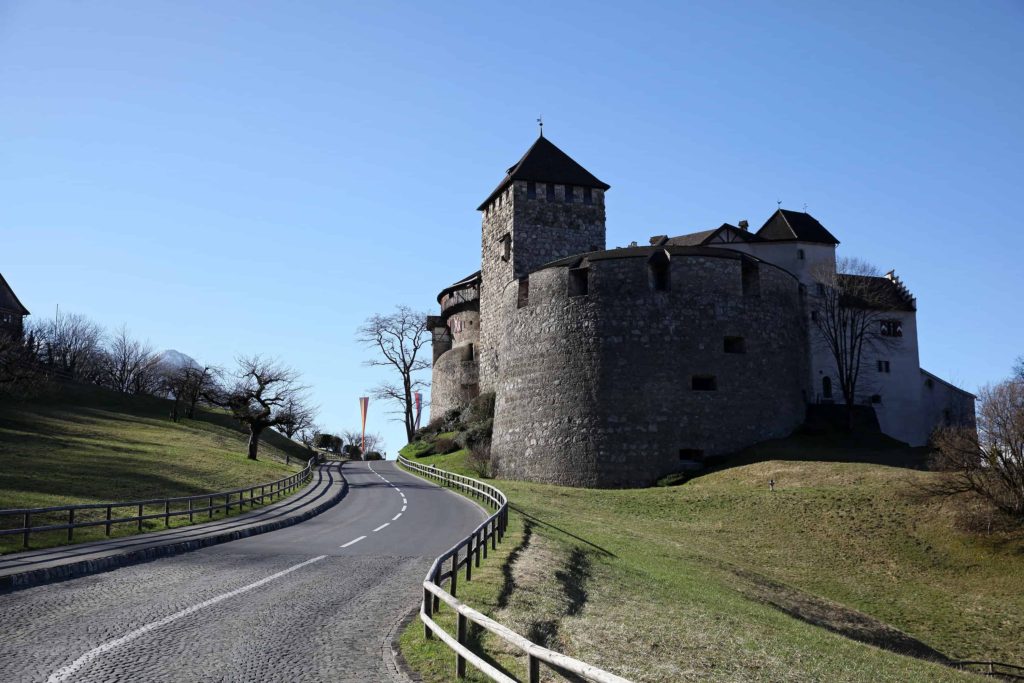
gutenberg castle
Gutenberg Castle, an intact castle in the town of Balzers, Liechtenstein, in the center of the municipality of Balzers, began its existence as a medieval church and cemetery on a hilltop. In the early 12th century, fortification of the area began with the addition of a ring wall, forming a simple, roughly circular keep. During the 12th century, several additions followed, in particular the creation of the main tower by raising the height of the existing keep. Later on, the tower was fitted with merlons. In the 12th and early 13th century, the castle was owned by the lords of Frauenberg, a noble family from the Swiss canton of Graubünden. After the death of Heinrich von Frauenburg in 1314, the castle became the property of the House of Habsburg. It was then used primarily for guarding the borderlands between the local Habsburg-owned territories and those belonging to the independent Swiss cantons.
Unlike Vaduz Castle, Gutenberg Castle does not serve as a residence of the princely family of Liechtenstein and is open to the general public as a museum.
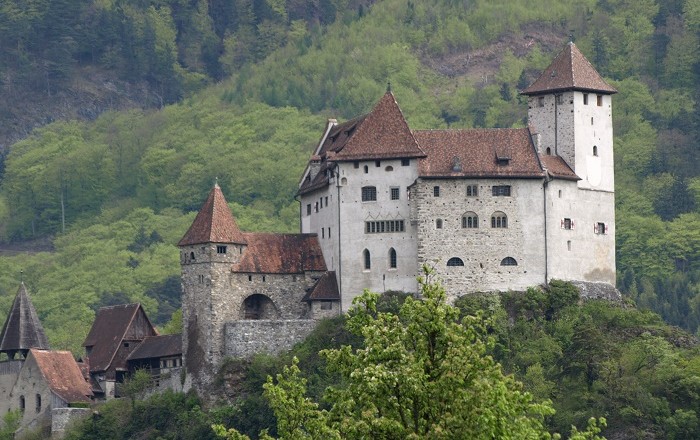
obere burg
Built around the year 1200 AD, Obere Burg (“Upper Castle”), also known colloquially as Burg Neu-Schellenberg (“Castle of Neu-Schellenberg”), is a castle ruin located in the municipality of Schellenberg, Liechtenstein. It lies at the western edge of Hinterschloss, one of the boroughs in the village of Neu-Schellenberg. It is freely open to tourists. Due to its close proximity to Hinterschloss, it is probably the most easily accessible of all Liechtenstein castles.
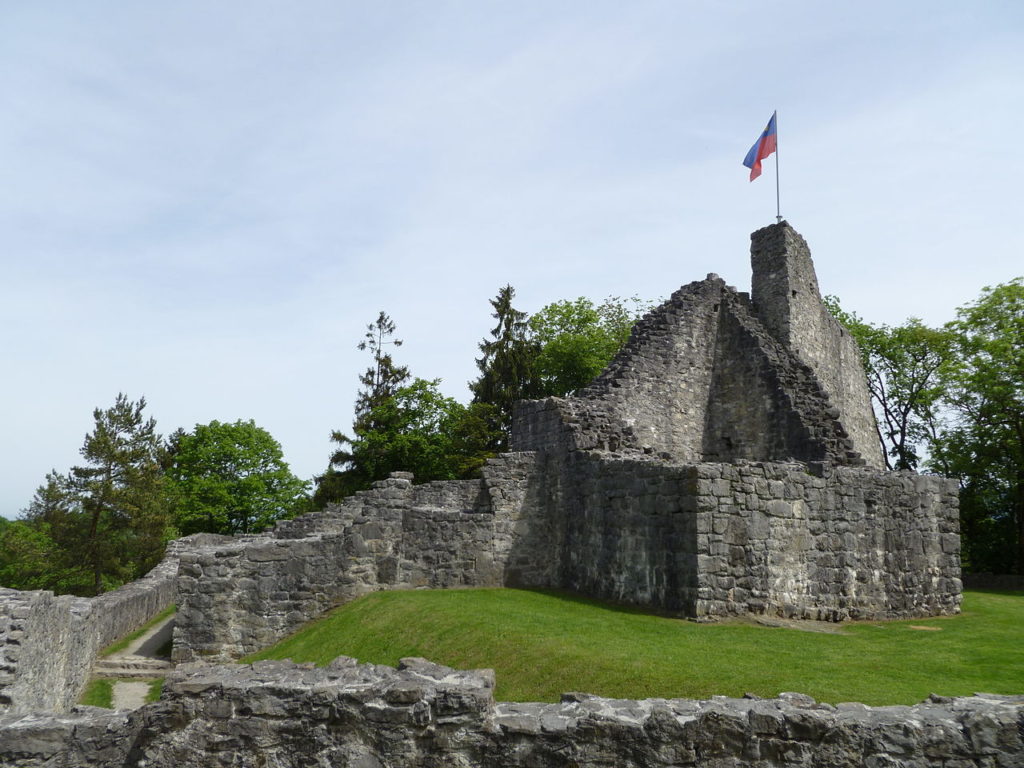
untere burg
Completed in 1250, Untere Burg (“Lower Castle”), also known colloquially as Burg Alt-Schellenberg (“Castle of Alt-Schellenberg”), is a castle ruin located in the municipality of Schellenberg, Liechtenstein. It lies at the edge of a local forest, a few hundred meters north of the main road between Vorderer Schellenberg and Mittleler Schellenberg (two of the burroughs in the village of Alt-Schellenberg). It is freely open to tourists and accessible by foot or mountain bike via a local footpath.
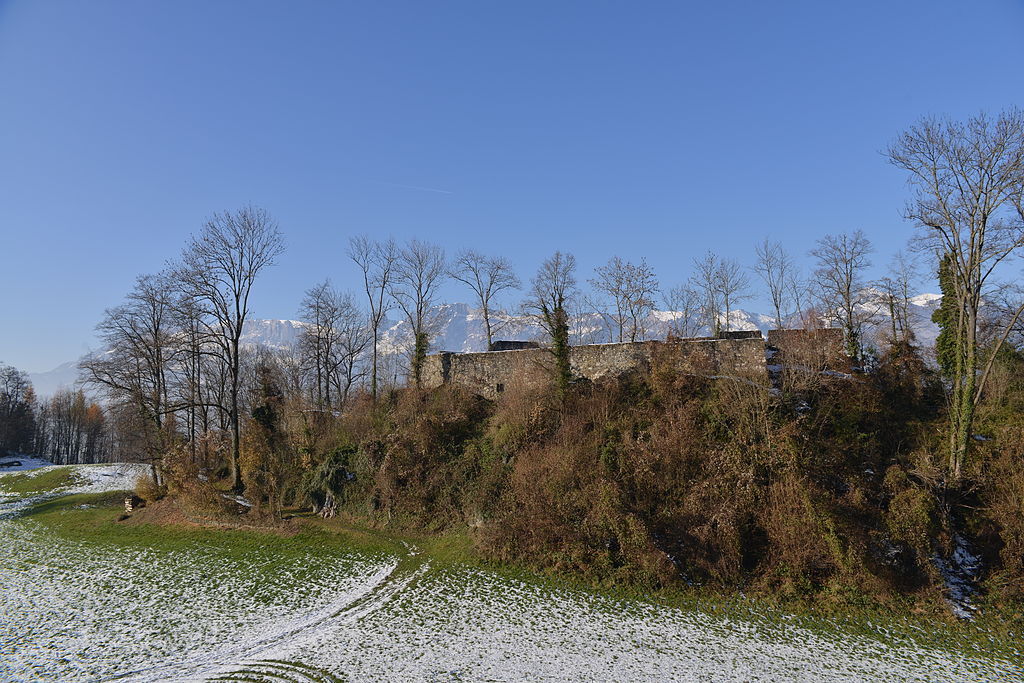
Shalun castle
Built near the end of the 12th century, Schalun Castle, also known colloquially as Wildschloss (“Castle in the wild”), is a castle ruin located in the municipality of Vaduz, Liechtenstein. It lies in the mountains, roughly 1 kilometer to the northeast from the town centre of Vaduz, the capital of Liechtenstein. It is freely open to tourists and accessible by foot or mountain bike via a local footpath.
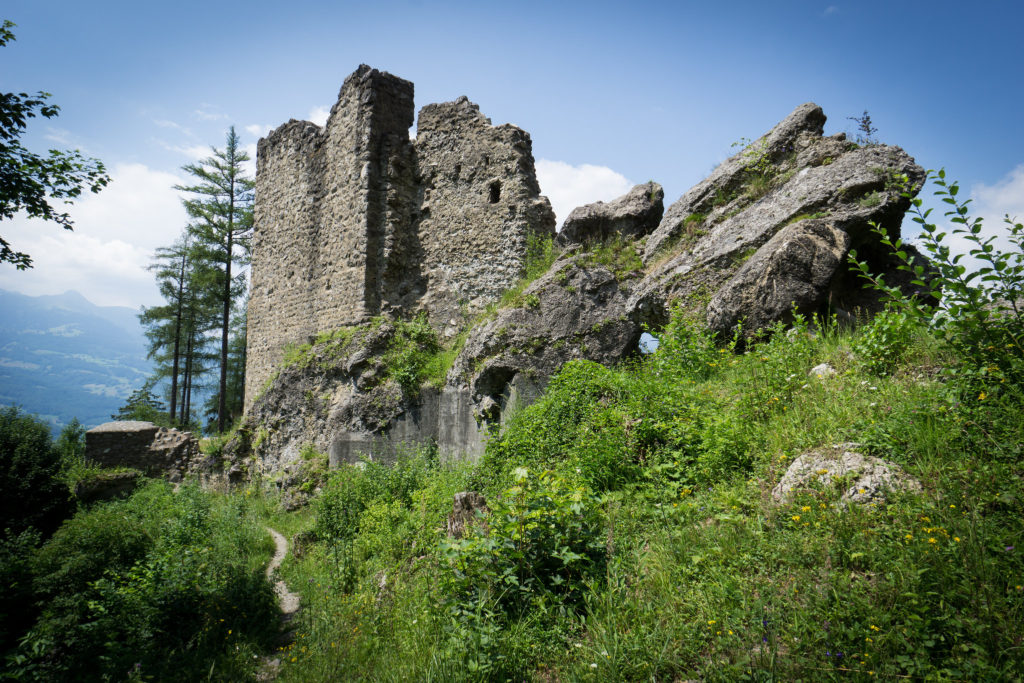
The prince of liechtenstein

his serene highness prince hans-adam ii
Prince Hans-Adam II is the eldest son of Prince Franz Josef II and Princess Gina. He is the first Prince of Liechtenstein to have grown up in Liechtenstein and is the 15th reigning Prince overall.
Prince Hans-Adam II was born on February 14, 1945, and grew up with his three brothers and his sister in the parental home at Vaduz Castle. He attended elementary school in Vaduz and was a member of the Vaduz scout troop.
In 1956, Prince Hans-Adam II entered the Schottengymnasium in Vienna, where his father Prince Franz Josef II had also studied. In 1960, he transferred to the Grammar School in Zuoz, which he completed in 1965 with the Swiss advanced-level diploma and the German Abitur certificate. After high school, Prince Hans-Adam II worked as a trainee at a bank in London. Besides his native language, German, he also speaks English and French.In autumn 1965 Prince Hans-Adam II took up his studies in Business and Economics at the University of St. Gallen, which he completed in 1969 with the degree of Licentiate.
On July 30, 1967, Prince Hans-Adam II married Countess Marie Kinsky of Wchinitz and Tettau. They have four children: Crown Prince Alois; Prince Maximilian; Prince Constantin; and Princess Tatjana.
In 1972, Prince Hans-Adam II, then still the Hereditary Prince, was entrusted by his father Prince Franz Josef II with reorganizing the assets of the Princely House.
In 1984, during the 45th year of his father’s reign, he was appointed to be his father’s permanent representative, and was entrusted with responsibility for state business. Prince Hans-Adam II assumed the regency on November 13, 1989, following the death of his father. On August 15, 2004, Prince Hans-Adam II appointed his eldest son, Crown Prince Alois, as his permanent representative, in preparation for his succession to the throne.
Crown Prince Alois was born in Zurich on June 11, 1968, as the eldest son of Prince Hans-Adam II and Princess Marie. Under the House Law of the Princely Family, Crown Prince Alois is destined to succeed to the throne. He has been performing the duties of Head of State of the Principality of Liechtenstein since August 15, 2004.
CROWN prince alois
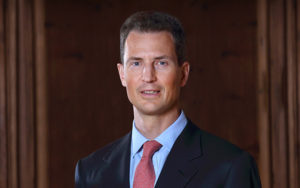
h.s.h crown prince alois
Crown Prince Alois was born in Zurich on June 11, 1968. He is the eldest son of Prince Hans-Adam II and Princess Marie. Under the House Law of the Princely Family, Crown Prince Alois is destined to succeed to the throne. He has been performing the duties of Head of State of the Principality of Liechtenstein since August 15, 2004.
The name Alois was given to the Crown Prince in memory of his great-grandfather, Prince Alois von Liechtenstein. Crown Prince Alois spent his youth at Vaduz Castle. He attended elementary school in Vaduz-Ebenholz, and entered the Liechtenstein Gymnasium in 1979. He graduated in the spring of 1987.
Subsequently, he entered the Royal Military Academy, Sandhurst, Great Britain, where he completed his officer’s training. On receiving his commission as Second Lieutenant, he served for six months in the Coldstream Guards in Hong Kong and London.
In October 1988, Crown Prince Alois enrolled as a student of jurisprudence at Salzburg University. He completed these studies in 1993 with a master’s degree. From September 1993 until May 1996, he worked for a firm of chartered accountants in London. Since then, he has been back in Vaduz where he is responsible for various aspects of the family’s assets.
On August 15, 2004, under Article 13bis of the Constitution of the Principality of Liechtenstein, Prince Hans-Adam II appointed Crown Prince Alois as his permanent representative in preparation for his succession to the throne. The Hereditary Prince has therefore been performing the duties of Head of State of the Principality of Liechtenstein, both nationally and internationally.
On July 3, 1993, Crown Prince Alois married Crown Princess Sophie in Bavaria. They have four children: Prince Joseph Wenzel; Princess Marie Caroline; Prince Georg; and Prince Nikolaus.
charitable interests of the prince's household
The Princes of Liechtenstein are pioneers, researchers, diplomats and patrons. They have always been engaged in various aspects of science and social welfare. The members of the Princely House are particularly involved in the following institutions in Liechtenstein and abroad:
The Liechtenstein Institute on Self-Determination at Princeton University supports research and teaching on the subject of self-determination by states.
The Liechtenstein Foundation for State Governance offers political, economic, and financial expertise in state governance for decision-makers.
The Liechtenstein Red Cross was established in 1945 on the initiative of Princess Gina. Following in her footsteps and those of Princess Marie (1985-2015), Hereditary Princess Sophie is currently its third President.
The Heilpädagogische Zentrum des Fürstentums Liechtenstein, a therapeutic education center in the Principality. Princess Marie-Aglaé assumed its presidency from Princess Gina and remains its patron to this day.
The Sophie of Liechtenstein Foundation for Woman and Child aims to give women who become pregnant unintentionally better prospects in life for themselves and their child. The Foundation also supports the schwanger.li advice center.
The LGT Venture Philanthropy Foundation is geared toward improving the livelihoods of disadvantaged people and giving them the chance of a better future.
For more information, and individual links to each of these organizations, visit https://www.fuerstenhaus.li/en/commitment-of-the-princely-house/patrons-of-science-and-social-welfare/
the prime minister

Prime minister daniel risch
Daniel Risch is a Liechtensteiner politician, and the incumbent Prime Minister of Liechtenstein, holding the position since March 25, 2021. He was previously Deputy Prime Minister and Minister of Infrastructure, Economic Affairs and Sports from 2017 to 2021, under the government of Adrian Hasler.
Prime Minister Risch studied business administration at the Swiss universities of St. Gallen and Zurich, as well as the Ludwig-Maximilian University in Munich from 1999 to 2003. He graduated with a degree in economics from the University of Zurich. He then started doctoral studies in business informatics at the University of Freiburg in 2004, and from 2006 to 2007 was a visiting scholar at the University of Melbourne, as part of a research stay. During this period, he also worked as a lecturer at the University of Applied Sciences of Northwestern Switzerland. He completed his studies at Freiburg in 2007 and received a doctorate in economics.
Prime Minister Risch is married to Jasmin Schädler and has two children.
decorations and honors of the house of liechtenstein
There is a long tradition in the House of Liechtenstein of recognizing outstanding service by bestowing titles, orders, and honors. The Princes of Liechtenstein themselves have received many awards for their services over the centuries.
As Head of State, the Prince can bestow titles. The most common titles awarded are: Prince’s Councilor, Prince’s Court Councilor, Prince’s Justice Councilor, Prince’s Commerce Councilor, Prince’s Education Councilor, and Prince’s Spiritual Councilor. On very rare occasions, aristocratic titles with the predicate “von” and the titles “Baron” or “Count” are awarded.
The Order of Merit of the Principality of Liechtenstein is an order of merit of the Principality of Liechtenstein that is awarded for services rendered to the principality. Prince Franz I founded the Order of Merit of the Principality of Liechtenstein on 22 July 1937
There order is presented in six grades.
Grand Star of the Princely Liechtenstein Order of Merit is the highest honor bestowed by the Princely House of Lichtenstein. It is worn as a hip decoration and breast star. The hip jewel is 62 mm in diameter. The center is blue with red border, golden framed cross with outwardly widening beams, which on a center shield of the same color in gold on the front the letter “L”.
The ribbon for the master decoration is 110 mm wide, namely 7 1/2 mm red, 15 mm blue, 65 mm red, 15 mm blue and 7 1/2 mm red. The ribbon for the women’s decoration is 65 mm wide, namely 5 mm red, 9 mm blue, 37 mm red, 9 mm blue, and 5 mm red
The breast star is a gold star formed from eight brilliantly equal-length rays, which measures 94 mm in diameter. In the center is the cross of the order depicting a golden “L”.
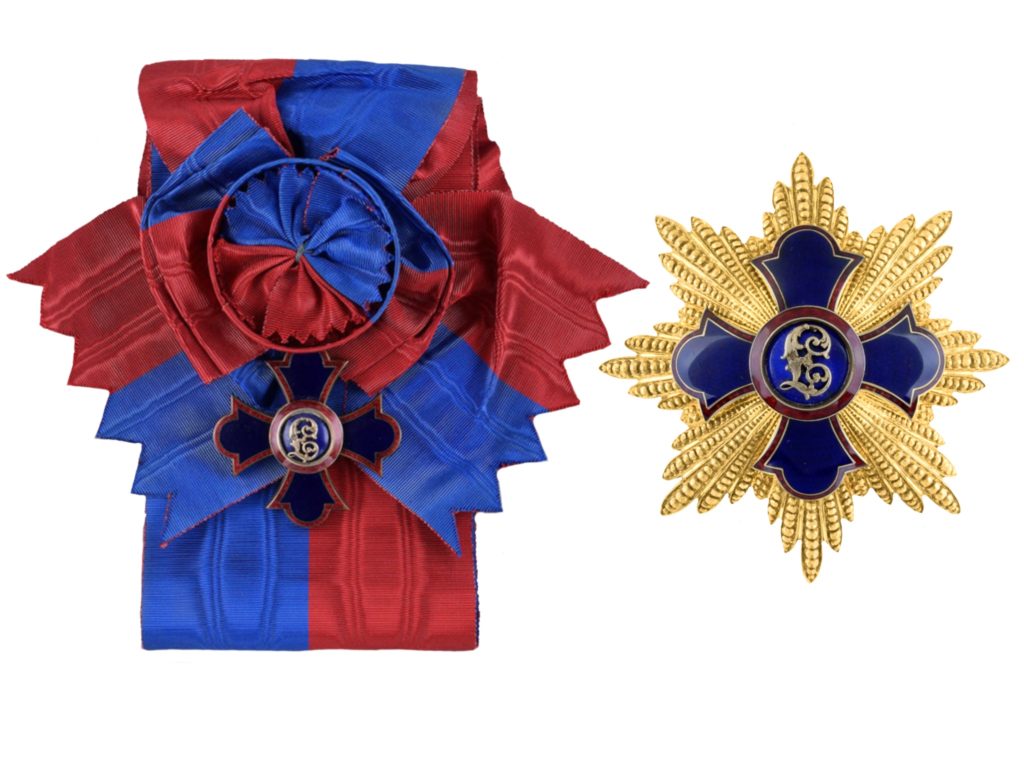
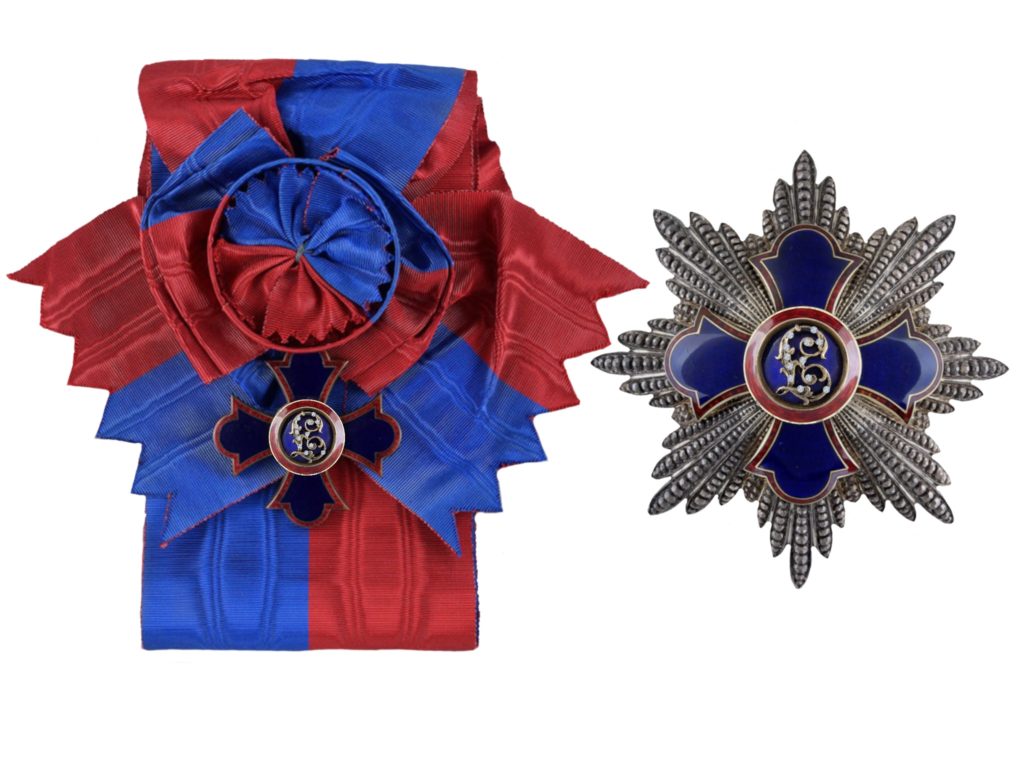
Grand Cross with Diamonds of the Prince’s Liechtenstein Order of Merit is the second highest honor bestowed by the Princely House of Lichtenstein. It is worn as a hip decoration and breast star. The hip jewel is 62 mm in diameter. The center is blue with red border, golden framed cross with outwardly widening beams, which on a center shield of the same color in gold on the front the letter “L”. Diamonds are set in to the letter “L”.
The ribbon for the master decoration is 110 mm wide, namely 7 1/2 mm red, 15 mm blue, 65 mm red, 15 mm blue and 7 1/2 mm red. The ribbon for the women’s decoration is 65 mm wide, namely 5 mm red, 9 mm blue, 37 mm red, 9 mm blue, and 5 mm red.
The breast star is a silver star formed from eight brilliantly equal-length rays, which measures 94 mm in diameter. In the center if the cross of the order with diamonds set in the “L”.
Grand Cross of the Prince’s Liechtenstein Order of Merit is the third highest honor bestowed by the Princely House of Lichtenstein. It is worn as a hip decoration and breast star. The hip jewel is 62 mm in diameter. The center is blue with red border, golden framed cross with outwardly widening beams, which on a center shield of the same color in gold on the front the letter “L”. On the back the initials of the founder “FIL”.
The ribbon for the master decoration is 110 mm wide, namely 7 1/2 mm red, 15 mm blue, 65 mm red, 15 mm blue and 7 1/2 mm red. The ribbon for the women’s decoration is 65 mm wide, namely 5 mm red, 9 mm blue, 37 mm red, 9 mm blue, and 5 mm red.
The breast star is a silverstar formed from eight brilliantly equal-length rays, which measures 94 mm in diameter.
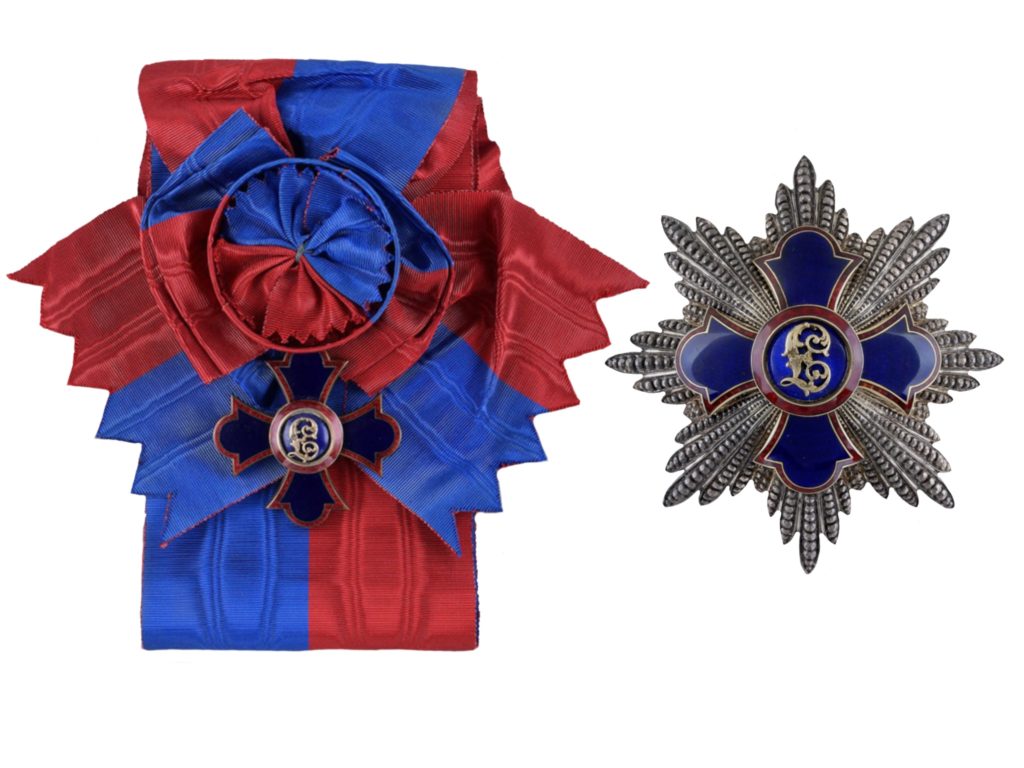
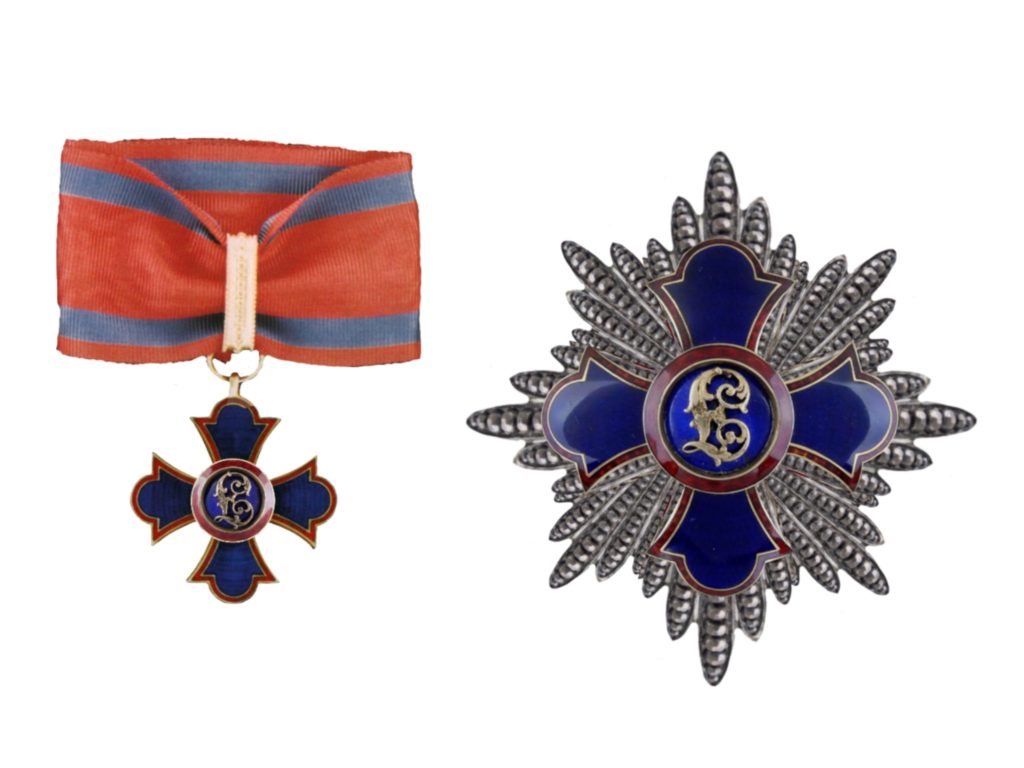
The Commander’s Cross with Star is the fourth highest order bestowed by the House of Liechtenstein. It consists of a neck decoration and breast star.
Neck decoration is the cross of the order. It is blue enameled with red border, golden framed cross with outwardly widening beams, which on a center shield of the same color in gold on the front the letter “L” and on the back the initials of the founder “FIL”. It is 54 mm in diameter.
Neck ribbon is 47 mm wide, namely 4 mm red, 7 mm blue, 25 mm red, 7 mm blue and 4 mm red.
The breast star is a silver star formed from eight brilliant rays, by which four rays have a diameter of 77 mm and four rays have a diameter of 66 mm, lies with a slightly curved beam the cross of the Order of Merit, diameter.
The Commander’s Cross is the fifth highest order bestowed by the House of Liechtenstein. It consists of a neck decoration.
Neck decoration is the cross of the order. It is blue enameled with red border, golden framed cross with outwardly widening beams, which on a center shield of the same color in gold on the front the letter “L” and on the back the initials of the founder “FIL”. It is 54 mm in diameter.
Neck ribbon is 47 mm wide, namely 4 mm red, 7 mm blue, 25 mm red, 7 mm blue, and 4 mm red.
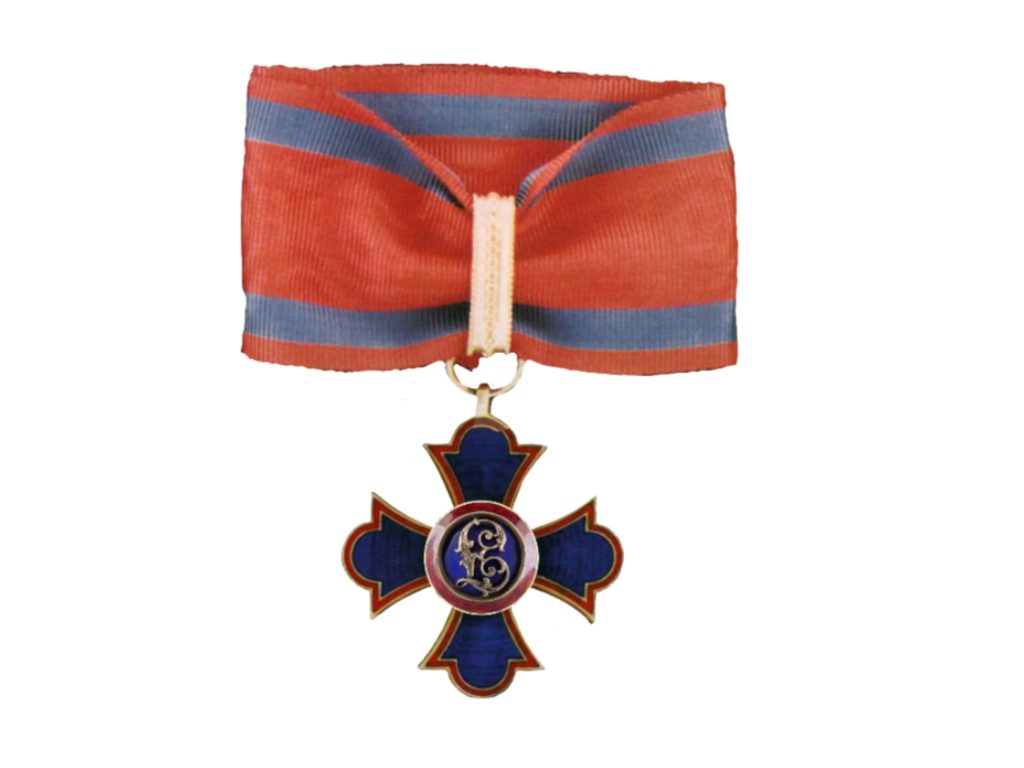
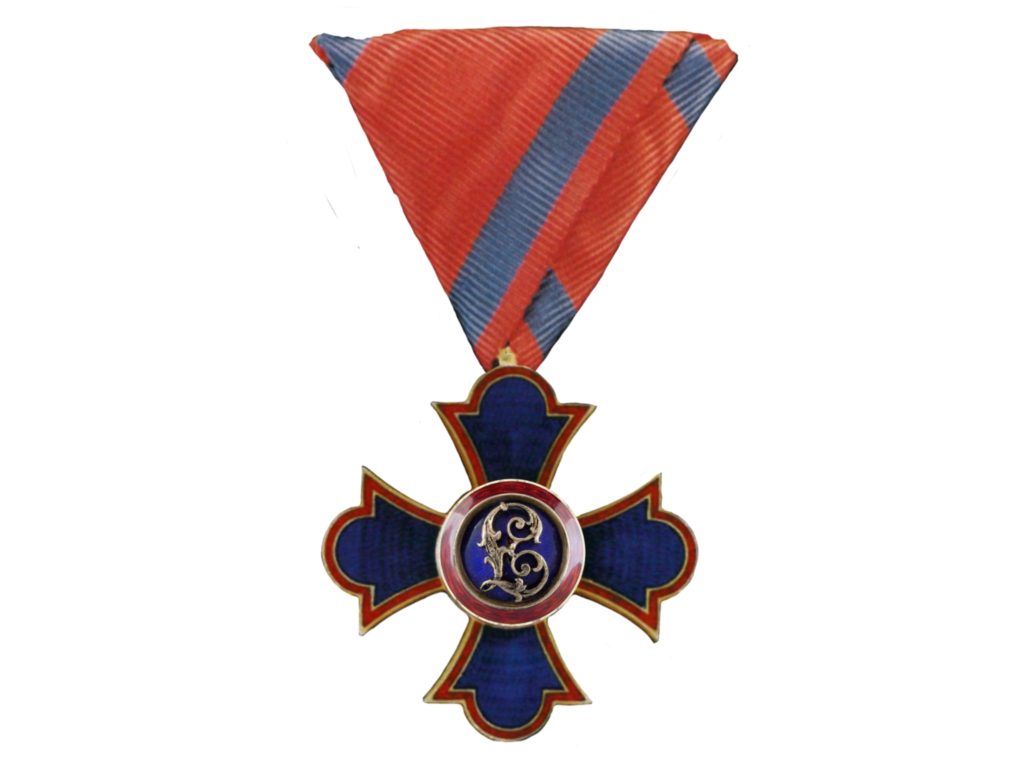
The Knights Cross is the sixth highest order bestowed by the House of Liechtenstein. It is the lowest order of knighthood awarded. It consists of a chest decoration.
The chest decoration is the cross of the order. It is blue enameled with red border, golden framed cross with outwardly widening beams, which on a center shield of the same color in gold on the front the letter “L” and on the back the initials of the founder “FIL”. It is 45 mm in diameter.
The ribbon is 40 mm wide, namely 3 mm red, 6 mm blue, 22 mm red, 6 mm, blue, and 3 mm red.
The Prince’s Liechtenstein Decoration of Merit is awarded as:
The Princely Liechtenstein golden badge of merit and Princely Liechtenstein silver medal of merit.
The person awarded the Badge of Merit can be considered “Owner” of the same. There are no other honorifics associated with this. The decorations remain the property of the persons to whom they were lent and their heirs.
The owner of the golden and silver badge of merit wears the Decoration on the triangular folded band on the left side of the chest. Women wear the golden and silver medal of merit at a mesh-like sewn band of the appropriate color and width.
The chest Jewel 45 mm in diameter and consists of a gold or silver cross with outwardly spreading beams, which is enameled on a blue with red central shield bearing bears the letter “L” in front and the initials of the founder, “FIL”, on the back. The Ribbon 40 mm wide and is blue and red.
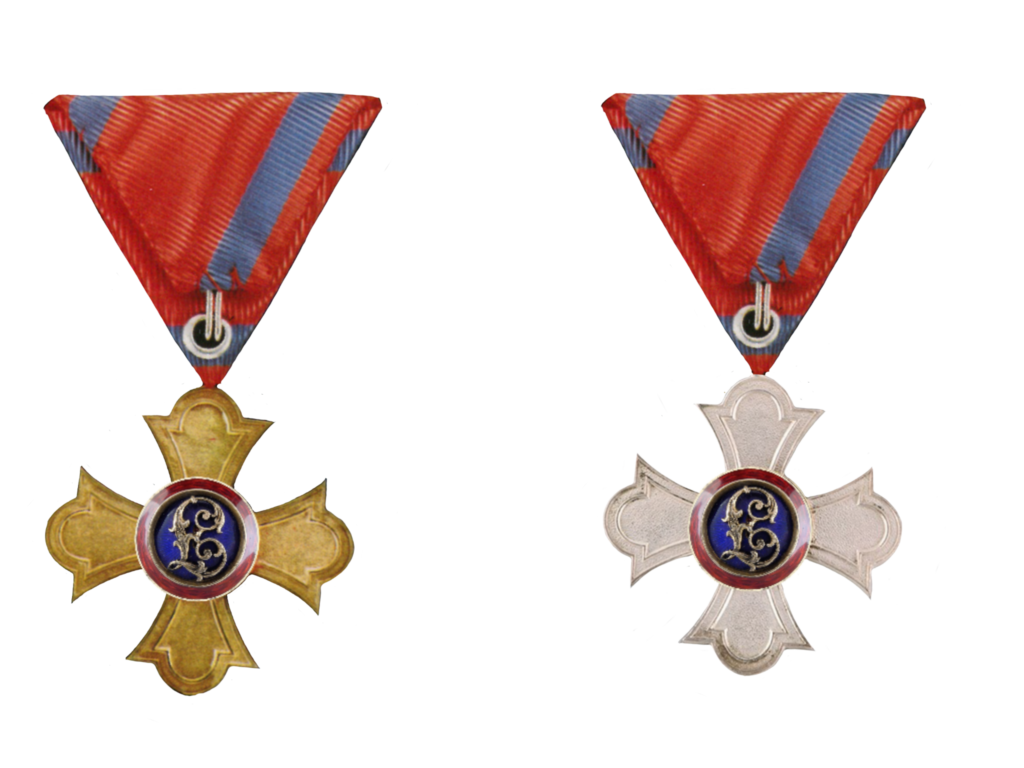
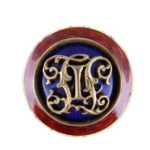
the back of the decoration bearing "FIL"
One of the smallest and richest countries in the world, Liechtenstein rests between Switzerland and Austria, among mountain ranges that rise above the Rhine.
This tiny German-speaking microstate has plenty to offer, from rolling mountains that go on forever, beautiful green valleys, and of course, castles and historic churches. Outdoor enthusiasts are in their element here, with a remarkable number of trails to hike and slopes to ski given the country’s size. Strike out into the Alpine wilderness beyond Vaduz and, suddenly, this landlocked micronation no longer seems quite so small.
For more information on Liechtenstein, visit the official tourism website at https://tourismus.li/en/. Additional information on the House of Liechtenstein can be found at their official website: https://www.fuerstenhaus.li/en/
